Learn to carry out a water quality simulation using the solute data object.
The solute data object supports:
- Single substance water quality simulations.
- Water quality simulations for multiple interacting solutes
- Parallel second-order model (2RA)
The InfoWorks WS Pro functionality for multiple interacting solutes is called Multi Solute Quality (MSQ) and is similar to EPANET’s MSX.
The InfoWorks WS Pro functionality for parallel second-order model (2RA) is a comprehensive bulk chlorine decay model for simulating residuals in water distribution systems (Fisher, I., Kastl, G., Sathasivan, A. (2017). Urban Water Journal 14 (4), 361-368). Selecting this option will pre-populate the values in the Solute Data Object dialog.
The Solute Data Object dialog is opened by dragging the solute data object from the tree view onto the main window, or by right-clicking the solute data object and selecting Open from the context menu.
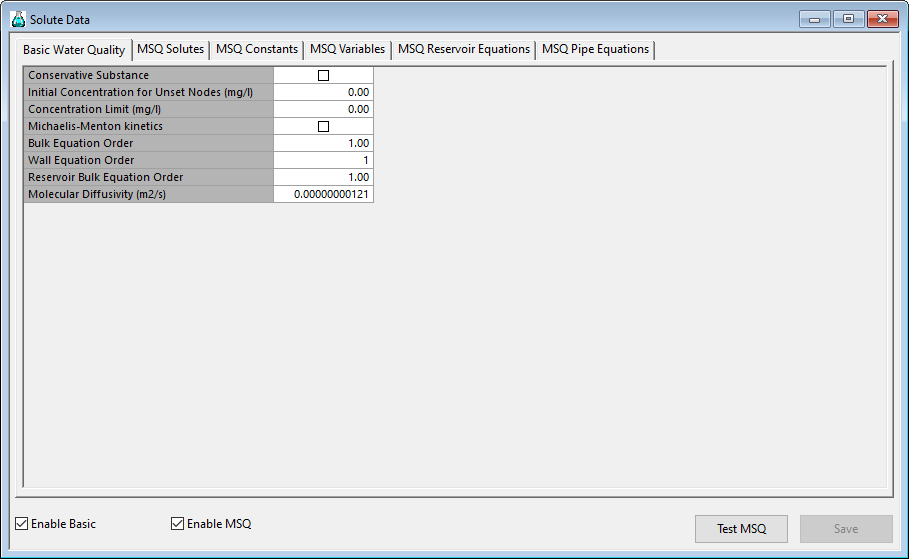
General dialog features
| Item | Description | |
|---|---|---|
| Enable Basic (checkbox) | If checked, enables single substance water quality simulations. |
Note: Basic water quality and MSQ can be simulated at the same time.
|
| Enable MSQ (checkbox) |
If checked:
|
|
| Test MSQ (button) | This will report any errors in the setup of the MSQ model. Note that when MSQ is applied to a network, there is additional validation. | |
| Save (button) | Saves any changes made to the dialog. |
Basic Water Quality tab
Here you specify single species water quality simulations.
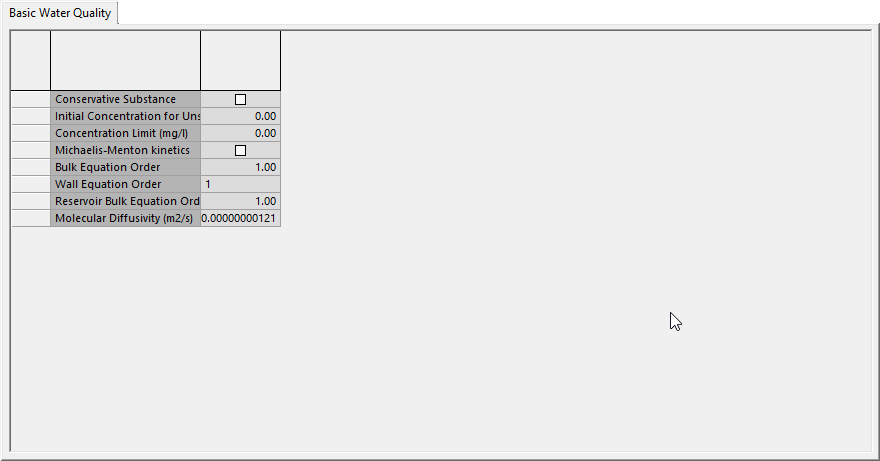
| Parameter | Default | Description | ||||
|---|---|---|---|---|---|---|
| Conservative Substance | Unchecked |
Check this box to model a conservative substance: bulk and wall coefficients are assumed to be zero. Leave this box unchecked to model a non-conservative substance: bulk and wall coefficients defined for pipes are used when calculating decay values. |
||||
| Initial Concentration for Unset Nodes | 0.00 mg/l |
The initial concentration of the substance being tested at the start of the simulation. This value is used for nodes at which the initial concentration has not been set (editable on the Water Quality Profile page of the Node property sheet).
|
||||
| Concentration Limit | 0.00 mg/l |
Limiting concentration used in the calculation of the bulk and reservoir reaction equations. The concentration is not allowed to go below the Concentration Limit in the case of solute decay, and conversely the concentration is not allowed to go above the Concentration Limit in the case of solute growth (i.e. positive values of bulk coefficient). |
||||
| Michaelis-Menton Kinetics | Unchecked | Check this box to use the Michaelis-Menton rate equation when calculating reaction rates. The equation produces first-order behaviour at low concentrations and zero-order behaviour at higher concentrations. This setting overrides the Bulk Equation Order (applies a value of -1). This setting does not affect the Reservoir Bulk Equation Order. | ||||
| Bulk Equation Order | 1 | Reaction order used in the calculation of bulk flow reaction rate. Use 0 for zero-order reactions, 1 for first-order reactions, 2 for second-order reactions, and so on. Use any negative number for Michaelis-Menton Kinetics. Values between 0 and 1 default to 0. | ||||
| Wall Equation Order | 1 | Reaction order used in the calculation of pipe wall reaction rate. Choices are 1 for first-order reactions or 0 for constant rate reactions. Any non-zero value defaults to 1. | ||||
| Reservoir Bulk Equation Order | 1 | Reaction order used in the calculation of reaction rate of a substance with material in a reservoir. Calculated independently to the Pipe bulk equation order, but the same limitations apply to the choice of values. | ||||
| Molecular Diffusivity | 1.21x10-9 m2/s | Molecular diffusivity of substance being transported, used in the calculation of pipe wall reaction rate. |
MSQ Solutes tab
Here you define any number of solutes.
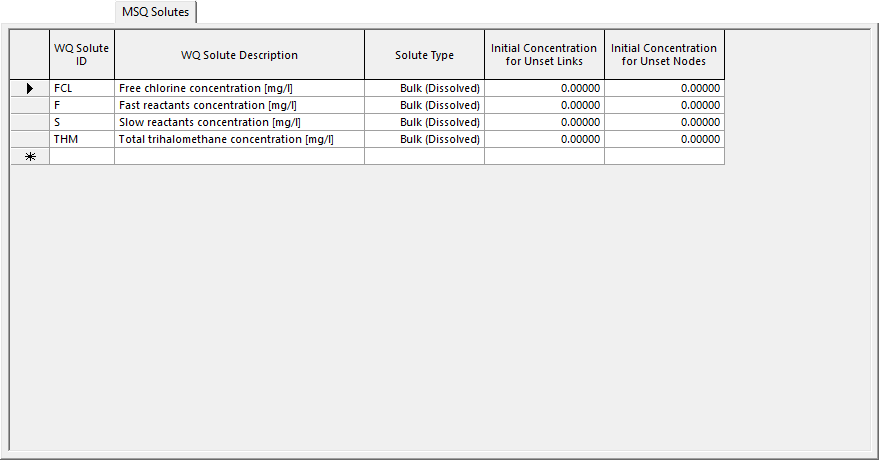
| Item | Description |
|---|---|
| WQ Solute ID |
The solute IDs are used in property sheets and in the results. All IDs must be unique within this grid. Note: If you define a solute that ends in _EXP, then it will show it as Exposure in hours when the results are opened. It takes whatever is before _EXP and appends Exposure to it. In the
Select What To Graph dialog, it becomes an item that you can select to graph. You can set the Exposure time to hours/minutes in the
Options dialog - Units page. By default, it is set to hours.
|
| WQ Solute Description | The description of the water quality solute ID. |
| Solute Type | Specifies whether the solute is present in the bulk liquid or on the pipe walls. |
| Initial Concentration for Unset Links |
Concentrations are defined as follows:
Initial concentrations can be set for:
Note: these initial concentrations are for “unset nodes” or “unset links”. They are global default values that can be overridden for individual model objects.
|
| Initial Concentration for Unset Nodes |
MSQ Constants tab
Constants are used to make equations clearer to read and are optional.
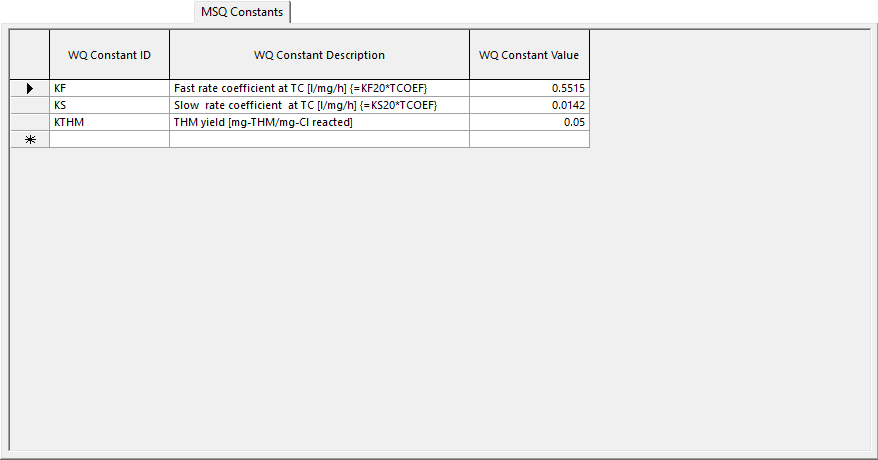
Any number of constant IDs can be defined with associated numerical values. The constant IDs are replaced by the numerical values when the engine acts upon the equations.
MSQ Variables tab
Variables are used to make equations clearer to read and are optional.
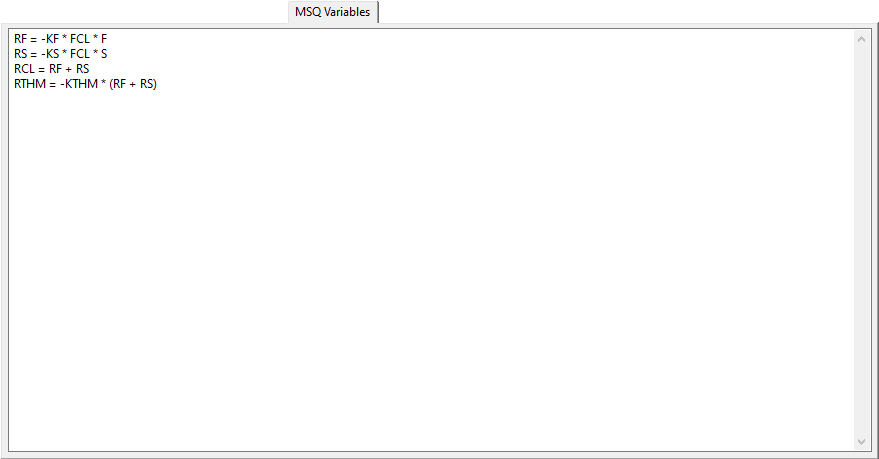
Variable IDs are defined, one per line in the text editor. Variables define an expression by combining constants, numerical values, algebraic operators, and reserved keywords.
MSQ Reservoir Equations tab
The way that solutes change through time within reservoirs is defined in this tab.
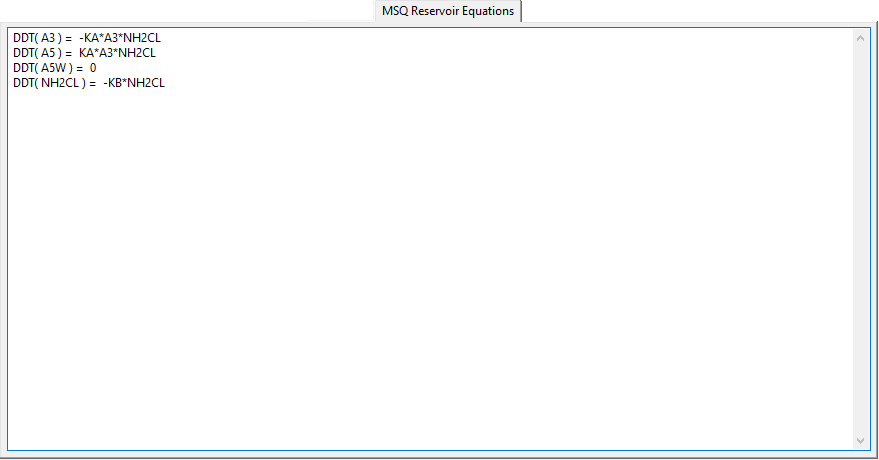
One solute is defined per line in this text box. Only dissolved (bulk) solutes are considered in this section.
- a rate of change, designated “DDT (A5) = ….”
- reversible reactions (that is, equilibria) are designated “A5 = …”. This is designed for rapid reactions.
The equation for each solute is composed of numbers, arithmetic operators, constants, variables, and solute IDs.
MSQ Pipe Equations tab
The way that solutes change through time in pipes is defined in this tab. This deals with changes to adsorbed solutes as well as those dissolved in the bulk of the water.
The construction of equations for Pipes follows the same rules as for reservoirs. The exception is that pipe equations can also include adsorbed solutes.
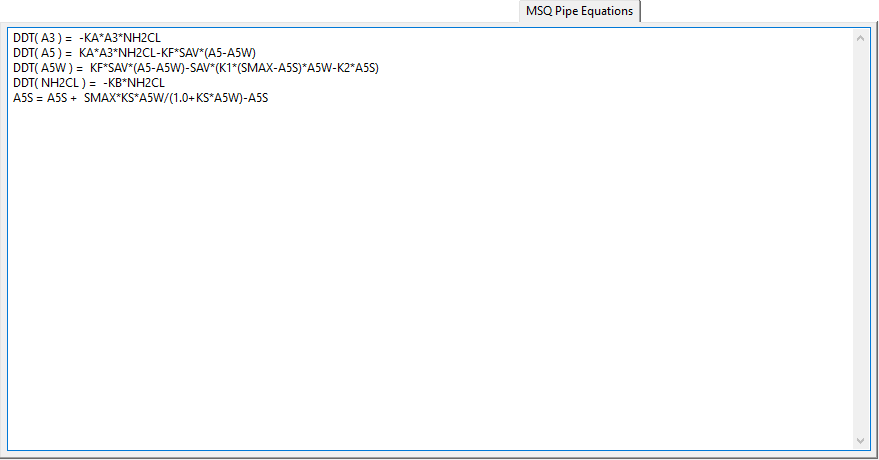
Keywords and operators for the MSQ variables and equations tabs
Keywords
| DIAM | Pipe diameter |
| LEN | Pipe length |
| SAV | Pipe surface area per unit volume |
| FLOW | Pipe flow |
| VEL | Pipe velocity |
| RE | Reynolds number |
| VSH | Shear velocity |
| DWF | Darcy-Weisbach friction factor |
| CWK | Colebrook-White roughness |
| HWC | Hazen-Williams coefficient |
Operators
| '(' |
| ')' |
| '**' and '^' are alternative forms of exponent operator |
| '*' |
| '/' |
| '+' |
| '-' |
| '=' |
Right side functions
| SIN( ) | COS( ) | TAN( ) | COT( ) | |
| ABS( ) | SGN( ) | SQRT( ) | LOG( ) | EXP( ) |
| ASIN( ) | ACOS( ) | ATAN( ) | ACOT( ) | |
| SINH( ) | COSH( ) | TANH( ) | COTH( ) | |
| LOG10( ) | STEP( ) |
Left side function
| DDT() | rate of change of solute |
